7 Beginner-Friendly Projects to Get You Started with ChatGPT
And to unleash the power of AI in today’s world.
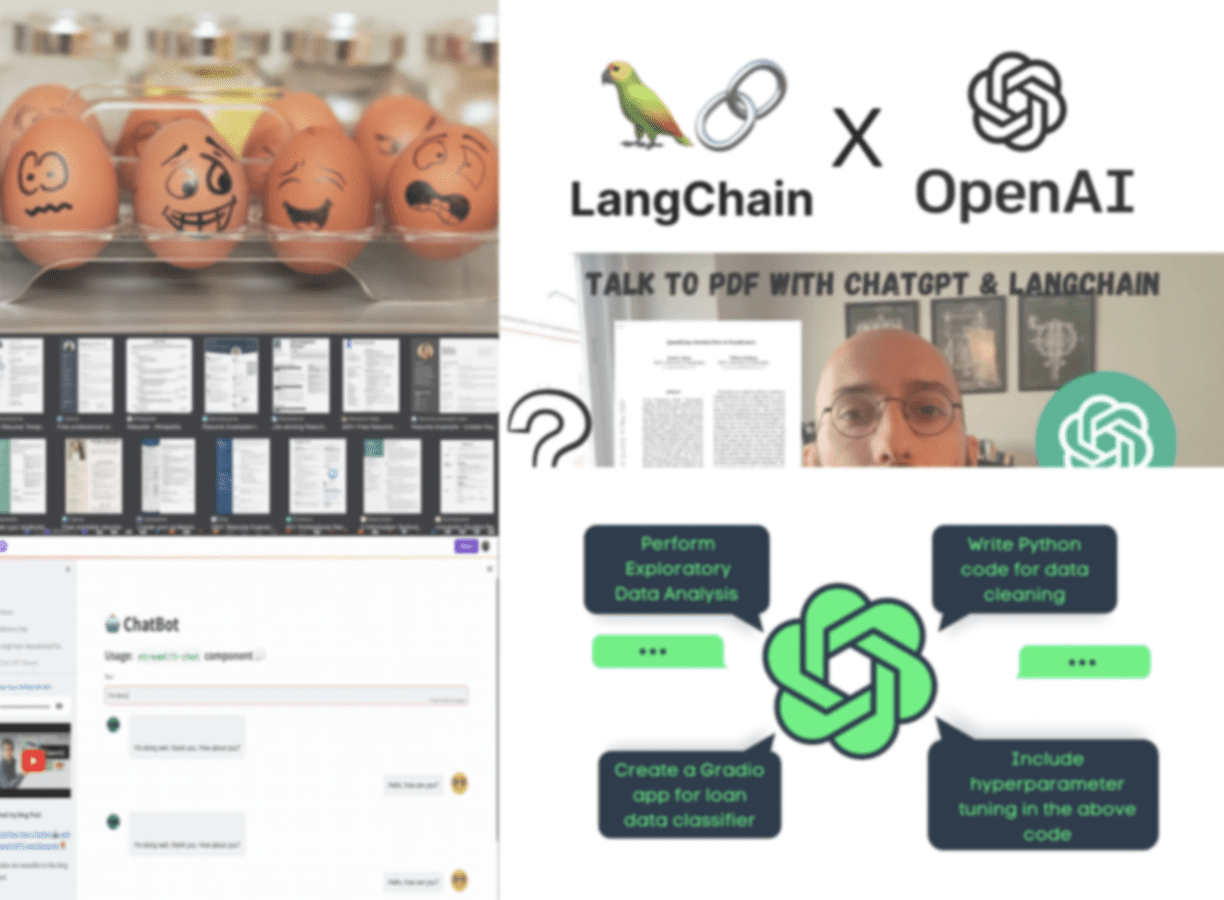
Image by Author
In an era where technology is advancing at an unprecedented pace, Artificial Intelligence?—?or AI for friends 🤓 stands out as one of the most transformative forces.
From automating mundane tasks to predicting complex patterns, AI is reshaping industries and redefining possibilities.
And as we stand on this AI revolution, it’s imperative for us to understand its potential and integrate it into our daily workflow.
However… I know it can be overwhelming to get started with these new technologies.
So, if you are wondering how to get started with AI, especially with models like ChatGPT…
Today I am bringing a set of 7 projects to learn from scratch how to deal with it.
Let’s discover them all together! 👇🏻
1. Generate a language translator using the OpenAI API
LLMs present a wide variety of applications. And one of the most useful?—?and easiest?—?to apply is precisely its ability to translate from any language to any other one.
In the tutorial Building a Multilingual Translation Tool with OpenAI ChatGPT API by Kaushal Trivedi, readers are guided through creating an AI-driven translation application using OpenAI’s gpt-3.5-turbo model via its API.
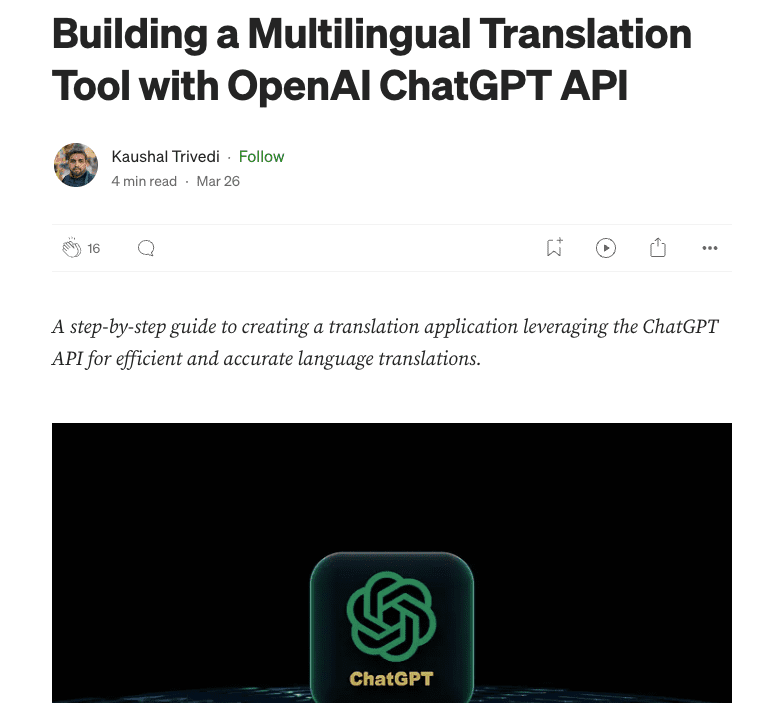
Screenshot of the tutorial.
The process involves the following steps:
- Setting up OpenAI API credentials.
- Defining a translation function using Python and the OpenAI API.
- Testing the function.
- Creating a user interface with Python’s Tkinter library.
- Testing the user interface.
The key lesson is the potential of the GPT-3.5 Chat API in building powerful AI-powered tools. In this case, used for creating a translation tool.
2. Use ChatGPT to build a sentiment analysis AI system for your business
Another common application for LLM is dealing with huge amounts of text. Imagine you run an e-commerce that receives thousands of comments every single day?—?you could take advantage of AI-powered tools to deal with them.
This is precisely what Courtlin Holt-Nguyen shows us throughout his tutorial Sentiment Analysis with ChatGPT, OpenAI, and Python?—?Use ChatGPT to build a sentiment analysis AI system for your business. He performs the whole tutorial on Google Colab and tries to emphasize the versatility of ChatGPT in handling various NLP tasks, the importance of structured data for effective analysis, and the capability of ChatGPT to reason and explain its responses.
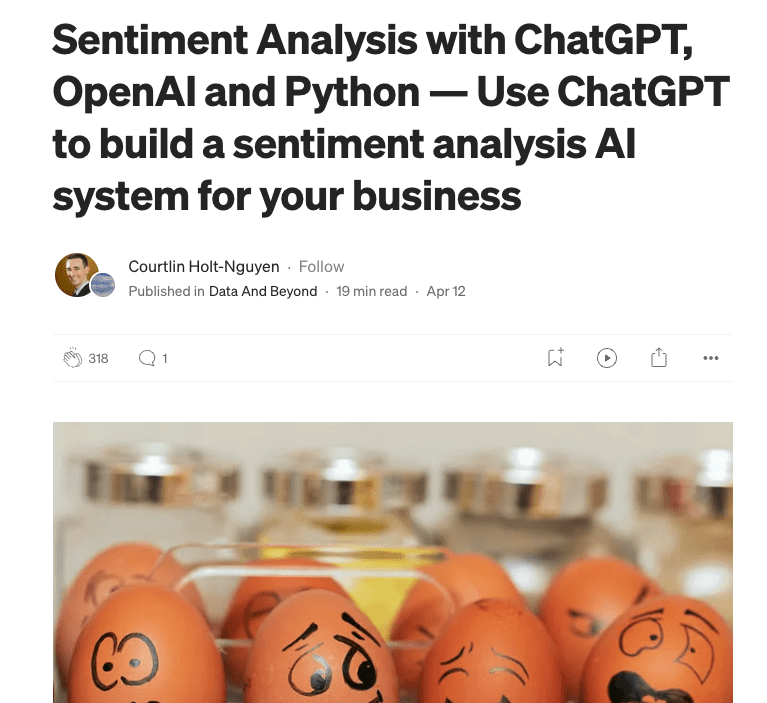
Screenshot of the tutorial.
Here are the key steps:
- Describes the dataset to be used. You can use his dataset or choose any other one you prefer.
- Introduces the OpenAI API.
- Installation of required libraries in Google Colab and starts using ChatGPT OpenAI API for Sentiment Analysis.
- Specific applications of the GPT model dealing with reviews.
ChatGPT’s powerful AI capabilities can be harnessed for comprehensive sentiment analysis, summarization, and actionable insights from customer reviews.
3. Basic usage of LangChain and OpenAI
Last month I wrote an easy-to-follow basic introduction to LangChain called Transforming AI with LangChain: A Text Data Game Changer, a Python library designed to maximize the potential of Large Language Models for text data processing.
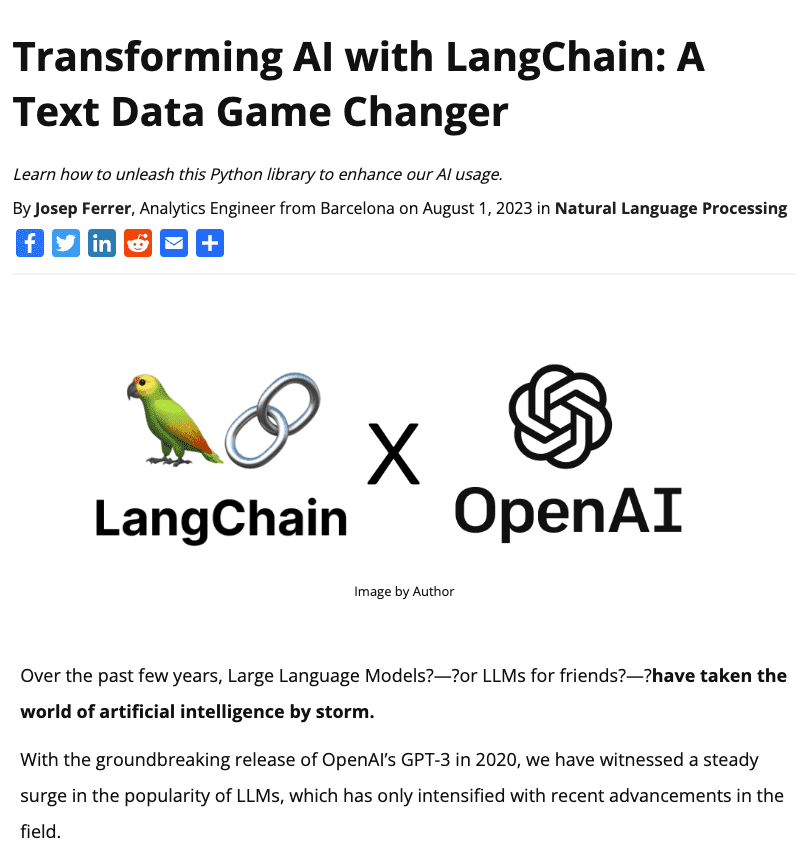
Screenshot of the tutorial
The versatility of LangChain when handling large text data and its capability to provide structured output has allowed it to become one of the most used Python libraries to deal with LLM and create real-live tools.
The tutorial explains two simple use cases of this library that can be applied in multiple applications.
- Summarization:
- Short Text Summarization: Using LangChain and ChatGPT to summarize short texts.
- Long Text Summarization: Handling longer texts by splitting them into smaller chunks and summarizing each chunk.
- Extraction:
- Extracting Specific Words: Identifying specific words within a text.
- Using LangChain’s Response Schema: Structuring the output from the LLM into a Python object.
LangChain offers a robust framework for text summarization and extraction, simplifying the process of natural language processing applications.
4. Automating PDF Interaction with LangChain and ChatGPT
Following the previous tutorial, there is a more advanced article that teaches how to ingest a PDF and interact with it using the GPT model of OpenAI.
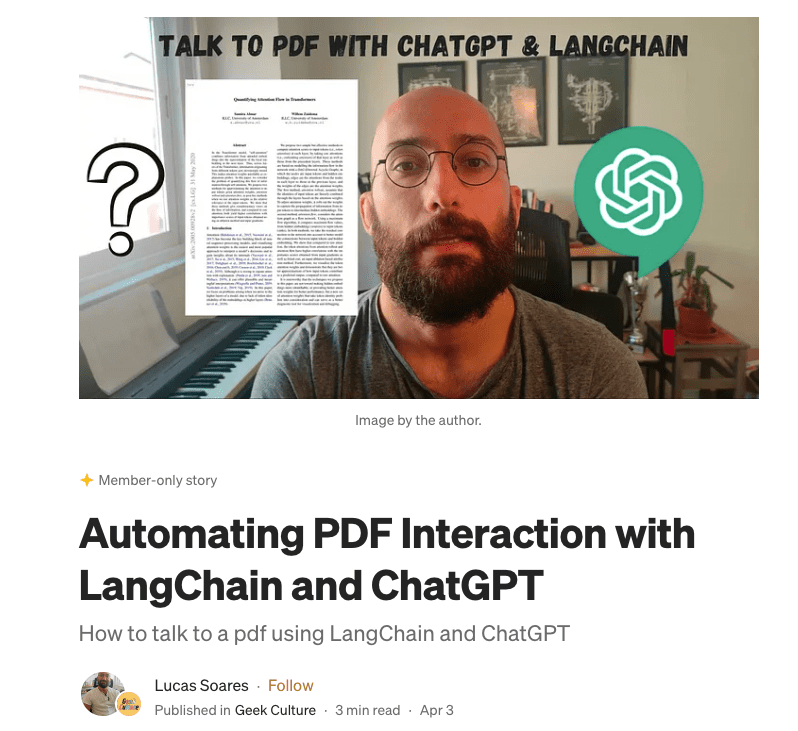
Screenshot of the tutorial.
Lucas Soares shows us throughout his tutorial Automating PDF Interaction with LangChain and ChatGPT how to leverage ChatGPT and the LangChain framework to interact with PDFs. The process is divided into three main steps:
- Loading the document.
- Generating embeddings and vectorizing the content.
- Querying the PDF for specific information.
This approach allows users to ask questions directly to a PDF, streamlining information retrieval. You can either follow his written article or watch his YouTube channel. Whatever you prefer!
The key lesson is the potential of AI in simplifying interactions with traditionally static documents, making data access more dynamic and intuitive.
5. Building up a Resume parser with ChatGPT
Reo Ogusu brings an easy-to-follow project to end up with a Resume Parser using the OpenAI API and LangChain. Throughout the tutorial Transforming Unstructured Documents to Standardized Formats with GPT: Building a Resume Parser he demonstrates how to transform unstructured documents, specifically resumes, into a standardized YAML format using GPT.
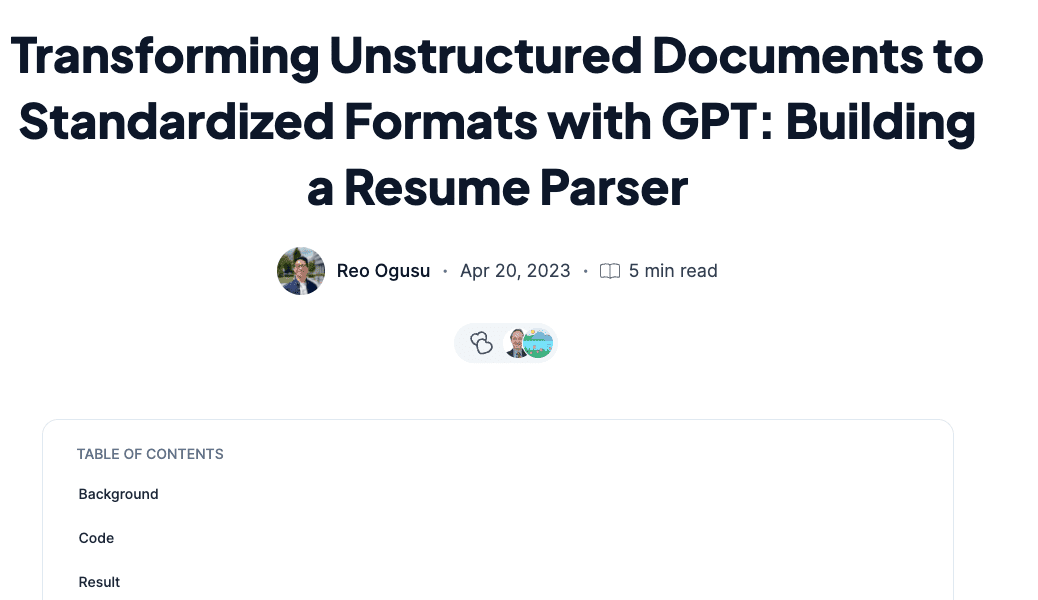
Screenshot of the tutorial
Here are the key steps:
- Extract text from PDFs using the PyPDF2 library.
- Utilize LangChain, a community-driven framework, to streamline the development of Language Model-powered applications.
- Define a YAML template for structuring the resume data.
- Call the OpenAI API using LangChain to instruct GPT to format the data according to the YAML template.
GPT proves to be a powerful tool for converting unstructured data into structured formats, offering the potential for various data conversion applications.
6. Generating a simple chatbot using OpenAI API
To generate a simple ChatBot we can follows Avra tutorial called How to build a Chatbot with ChatGPT API and a Conversational Memory in Python, where he explains how to build a chatbot implementation using the ChatGPT API and the GPT-3.5-Turbo model.
It integrates LangChain AI’s ConversationChain memory module and features a Streamlit front-end.
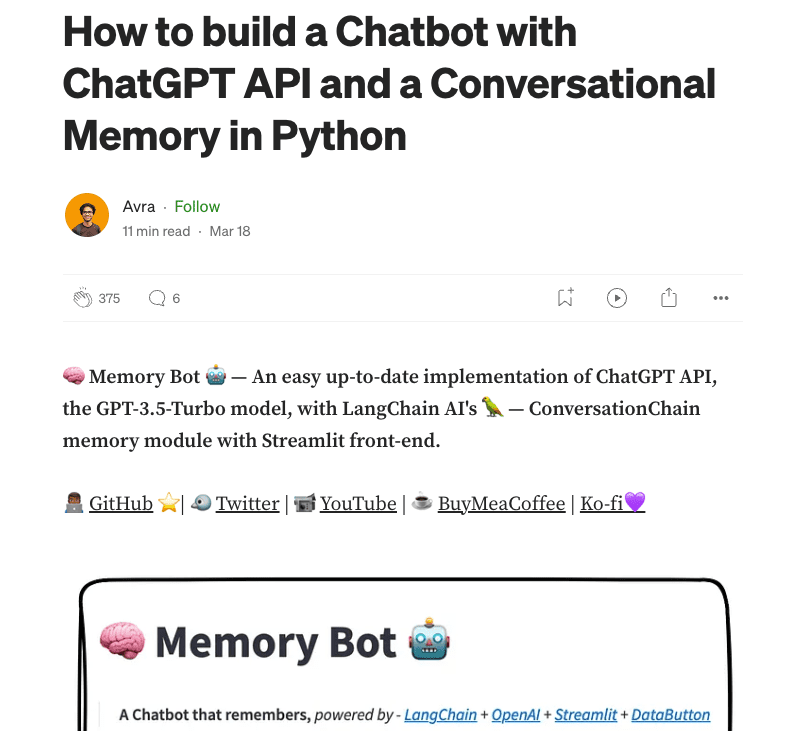
Screenshot of the tutorial.
The article emphasizes the importance of conversational memory in chatbots, highlighting that traditional chatbots, being stateless, lack the ability to remember past interactions.
By incorporating memory, chatbots can offer a more seamless and natural conversational experience, resembling human-like interactions.
The key takeaway is the significance of context retention in enhancing chatbot-human communication.
7. An End-to-End Data Science Project with ChatGPT
As a final project, I am bringing a really interesting data science tutorial that uses the ChatGPT interface directly.
Abid Ali Awan teaches us through his tutorial A Guide to Using ChatGPT For Data Science Projects on integrating ChatGPT into various stages of a data science project. It showcases the power of ChatGPT in the realm of data science.
From project planning and exploratory data analysis to feature engineering, model selection, and deployment, ChatGPT can assist in every step.
The end product?
A fully functional web app for loan approval classification!
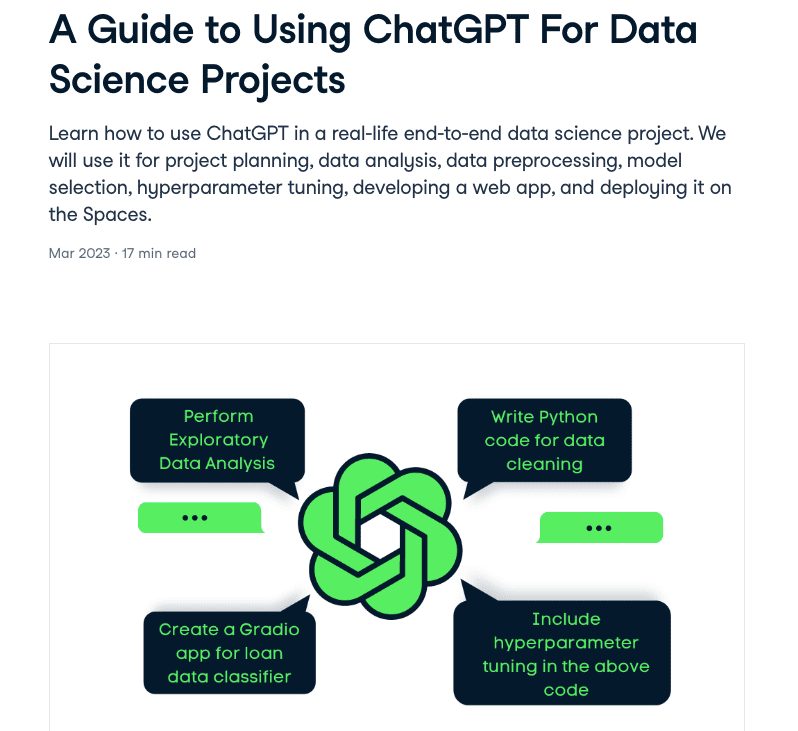
Screenshot of the tutorial.
the tutorial covers:
- Project Planning: Engaging with ChatGPT to outline the project.
- Exploratory Data Analysis (EDA): Leveraging Python for data visualization and understanding.
- Feature Engineering: Enhancing data by creating new features.
- Preprocessing: Cleaning data, handling class imbalances, and scaling features.
- Model Selection: Training various models and evaluating their performance.
- Hyperparameter Tuning: Optimizing the chosen model.
- Web App Creation: Designing a Gradio-based web app for the loan data classifier.
- Deployment: Launching the app on Hugging Face Spaces.
The tutorial emphasizes the power of ChatGPT in automating and enhancing various data science tasks, especially in project planning and code generation.
The key takeaway is the synergy between AI tools like ChatGPT and human expertise, where both complement each other to achieve optimal results.
Concluding Thoughts
The set of projects described above is just the tip of the iceberg when it comes to the potential of ChatGPT.
The open-source community is actively working to develop new tools and improve existing ones that can help you craft anything you can think of. LangChain is only one of the many examples out there.
This is why whether you’re still a learner of ChatGPT or a senior pro, always remember that in the world of AI, the only limit is your imagination!
So, why wait?
Dive in, experiment, and let the world of generative AI models open doors to endless possibilities!
Josep Ferrer is an analytics engineer from Barcelona. He graduated in physics engineering and is currently working in the Data Science field applied to human mobility. He is a part-time content creator focused on data science and technology. You can contact him on LinkedIn, Twitter or Medium.
